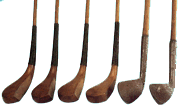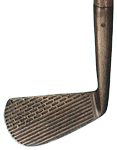
 As golf continued to evolve over the years, the golf club saw quite a few changes. When the evolution of the golf ball made the ball harder and more durable, a change in club head design was necessary; the guttie ball was putting far too much stress on these wooden clubs. The bulging head design on the wooden clubs held up for a few years, but by the turn of the 20th century aluminum had become the material of choice for club heads. The shape of the grassed drivers also changed from the bulged design of the drivers to what is now known as an iron; these were made out of hand-forged aluminum complete with a grooved face for increased backspin.
As golf continued to evolve over the years, the golf club saw quite a few changes. When the evolution of the golf ball made the ball harder and more durable, a change in club head design was necessary; the guttie ball was putting far too much stress on these wooden clubs. The bulging head design on the wooden clubs held up for a few years, but by the turn of the 20th century aluminum had become the material of choice for club heads. The shape of the grassed drivers also changed from the bulged design of the drivers to what is now known as an iron; these were made out of hand-forged aluminum complete with a grooved face for increased backspin.In the 1890's club designers produced a steel shaft to replace wooden shafts. However, the concept was used very little up until the early 1900's. Graphite shafts were introduced in the 1970's, serving as a lighter yet stronger alternative to steel shafts. Some shafts now come with a graphite-based mixture of materials that are said to enhance performance. For example, some clubs come with shafts that contain boran, which is said to help prevent twisting during a swing.
Wooden (or more specifically persimmon) drivers and fairway woods were not seen as obsolete until nearly the turn of the century. The first metal "woods" were made by Taylor-Made in the 1980's, and eventually became the replacement for wooden drivers due to its strength and versatility. The most recent trend with drivers is a combination of a graphite shaft with a titanium head, which allows the club head to be much larger then any drivers seen before. Taylor-Made also designed their r7 drivers with three adjustable weights integrated into the club head, which can help a person adjust both the trajectory and accuracy of his or her shot. Unfortunately this combination also allows for the most expensive clubs the sport of golf has ever seen.

Source: EDirectory.com
Source: GolfEurope.com
Source: Wikipedia
No comments:
Post a Comment